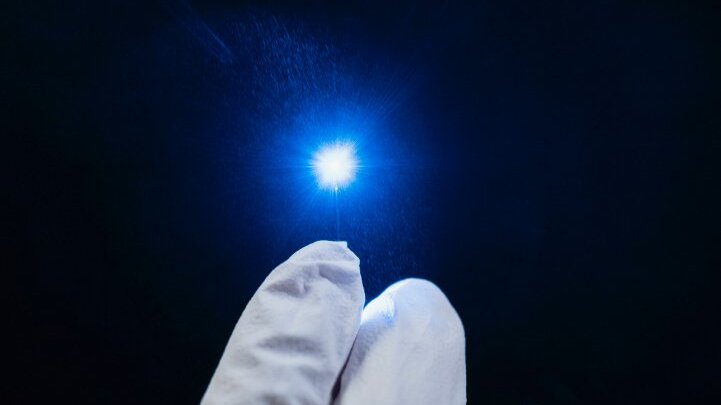
- Research
- Knowledge Transfer and Innovation
Published: | By: Lavinia Meier-Ewert
A European research team from Germany, the Czech Republic and Belgium is developing a new type of imaging technology to visualize neuronal processes in living organisms with high precision. The NEUROGATE project is based on a holographic endoscope that uses a hair-thin optical fibre to look deep into the brain – minimally invasive and with sub-cellular resolution. The European Innovation Council (EIC) is funding the further development of this technology with 2.5 million euros to test it for biomedical applications.
The holographic endoscope is based on a multimodal optical fibre that is thinner than a human hair. It enables the long-term observation of neuronal circuits in deep brain regions – even in freely moving organisms. This opens up new perspectives for research into neurological diseases such as Alzheimer's or epilepsy and could contribute to the development of innovative diagnostic and therapeutic approaches.
"This technology marks a turning point in neuroscience," says Prof. Dr Tomáš Čižmár, Head of Department at the Leibniz Institute of Photonic Technology (Leibniz IPHT) and Professor at Friedrich Schiller University Jena. "With NEUROGATE, we are taking it to the next level of development to study neuronal activity under natural conditions with unprecedented precision. These findings could significantly expand our understanding of neurological diseases."
Since 2017, Čižmár has been developing holographic endoscope technology in parallel at Leibniz IPHT, the University of Jena and the Institute of Scientific Instruments of the Czech Academy of Sciences (ISI) in Brno. In 2024, his work was recognized with two major awards: the prize of the Czech Minister of Education and the Life Sciences Prize of the European Microscopy Society.
Technology transfer: the start-up DeepEn
A key partner in the project is the Jena-based start-up DeepEn, which is driving forward the commercialization of the technology. The company was founded in 2024 by members of Čižmár's group at Leibniz IPHT. In the same year, DeepEn was honoured with the special prize for young companies at the Thuringian Innovation Award.
"Our goal is to translate scientific breakthroughs into marketable applications," explains Sergey Turtaev, CEO of DeepEn. "Holographic endoscopy has the potential to fundamentally change biomedical research – and NEUROGATE brings us a big step closer to this goal."
International collaboration for biomedical innovation
In cooperation with the Leibniz IPHT and DeepEn, two other partners are involved in NEUROGATE: the Institute of Scientific Instruments of the Czech Academy of Sciences (ISI) in Brno and the Neuro-Electronics Research Flanders (NERF) in Belgium. The interdisciplinary research centre for neurotechnology is supported by the company imec, the Institute for Biological Sciences VIB and the University of Leuven.
Dr Hana Uhlirova, who heads up the ISI's activities, emphasizes: "This project gives us the opportunity to test the technology under real-life conditions and make decisive advances in neuroscience." Prof. Sebastian Haesler from NERF adds: "We are delighted to contribute our expertise in the further development of neurotechnological applications in order to better understand the brain and develop new therapeutic approaches for neurological diseases."
From basic research to application
The aim of NEUROGATE is to bring the technology to Technology Readiness Level 6 (TRL6) – in other words, to validate it under realistic conditions. This is a crucial step in preparing the technology for use in biomedical research and later in clinical applications.
The project builds on Čižmár's successful ERC proof-of-concept funding at Leibniz IPHT and ISI. While WOKEGATE (Leibniz IPHT) enabled the development of ultrafine endoscopes to study neuronal networks, STROKEGATE (ISI) showed how this technology can be used to analyse the effects of strokes on the brain.
The consortium estimates the market for holographic endoscopes at more than 850 million euros. The technology could fundamentally change the diagnosis and treatment of neurological diseases.
"With NEUROGATE, we are demonstrating how basic research and technology transfer can be combined to develop solutions for socially relevant challenges," says Prof Čižmár.
07745 Jena Google Maps site planExternal link